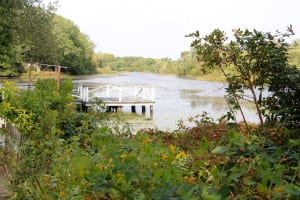Kent Animal Shelter has always been close to the Peconic Lake. Maybe too close.
The 47-year-old facility was built on River Road in Calverton less than 50 feet from Peconic Lake, which leads to Peconic River. As the lake flows into the river, so does the Shelter’s wastewater.
In 2012, the shelter began its process to get a waiver to expand its five-building facility and install a new septic system to avoid contaminating the Peconic’s surface water. According to Pamela Green, executive director of the shelter, the shelter also wants to tear down two of its building and construct one, approximately 10,000 square foot building closer to River Road. The hope is that relocating these buildings will put 300 feet between the shelter and the water, which will limit the amount of wastewater dumped into the Peconic Lake and river.
But Richard Amper, executive director of the Long Island Pine Barrens Society, said the shelter doesn’t qualify for the waiver for its prospective projects. Although Amper said the society doesn’t oppose the shelter’s projects, he said the facility’s desire to move closer to River Road infringes on Long Island Pine Barrens’ core preservation area. According to Amper, construction is not permitted by law in that area to help “protect the Island’s purest source of water.”
“The only way anyone can get a waiver is to demonstrate that they have no beneficial use of the property absent the waiver, or that public health and safety depends upon the construction occurring in the Pine Barrens core,” Amper said. “Kent does not meet that requirement, and if the waiver were granted, it would create a dangerous precedent for others who want to develop in the Pine Barrens core.”
Amper claimed that the shelter’s new proposed septic system would discharge 2,700 gallons of wastewater daily into the land’s underground aquifer. However, Green said the wastewater isn’t in close proximity to the aquifer for drinking water, as the wastewater goes into the Peconic.

Currently, the shelter wants to demolish its kennel, which rests on the river bank, as well as the small cottage located across from the kennel. The shelter also wants to relocate its clinic and include it into the nearly 10,000 square foot building, alongside a new kennel and cat facilities. One of the cat facilities, also on the bank of the Peconic, houses senior cats that will live out their lives at the shelter.
Thus far, the shelter has received permits from the New York State Department of Environmental Conservation and the Suffolk County Health Department.
“The last hurdle is the Pine Barrens commission,” Green said, about Central Pine Barrens Joint Planning and Policy Commission.
Where the commission differs from the Pine Barrens Society is that the commission decides whether the shelter will receive the waiver to expand its facility and upgrade its septic system. The commission is comprised of County Executive Steve Bellone (D); Brookhaven Town Supervisor Ed Romaine (R); Riverhead Town Supervisor Sean Walter (R) and Southampton Town Supervisor Anna Throne-Holst (D). A fifth individual will be added at a later date.
Amper said the society reached out to these supervisors, who are in the Pine Barrens towns, hoping that at least one of these officials will help provide the shelter with two to three acres of property for the shelter to expand and install a new septic system.
Green added that the Pine Barrens Society is threatening the commission with a lawsuit if the commission grants the shelter a hardship permit, which Green believes the shelter is eligible for as parts of the shelter are dilapidated and won’t be useful once the shelter cannot use the facility.
But Amper said this is a standard procedure. He also said even if the commission likes the shelter’s proposal, they can’t legally grant a waiver to the shelter to build on the area.
“If the commission is allowed to say, ‘We don’t care what the law says; we just like this project,’ then there’s no protection of the core area and the underground water supply,” Amper said. “The commission can’t make the law nor can they make decisions that contradict the law. It’s not that any of us dislike what they’re proposing; it’s not the value of the project, it’s where they’re proposing to build it.”
Romaine denied to comment on the issues and process the shelter is experiencing.
“As a member of the Central Pine Barrens Joint Planning and Policy Commission, it is not appropriate for me to comment at this time regarding an issue which is still under consideration,” Romaine said in an email.
The commission will vote on whether the shelter will receive a waiver on Oct. 21, at the Pine Barrens Commission meeting at Brookhaven Town Hall, according to Amper. The shelter will need three out of five votes to acquire the waiver to go through with its reconstruction plan, including the installation of a new septic system.
“We’re trying to prevent [surface water contamination] from happening by putting a new septic system and removing the channel off the river and abandoning the leaching field,” Green said. “This would be an upgrade for the environment.”






